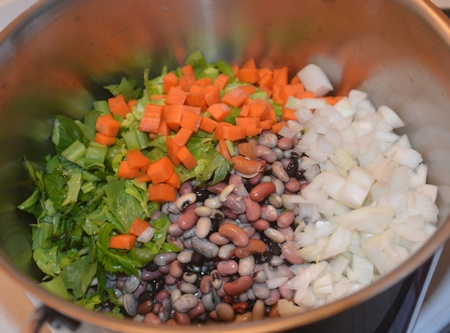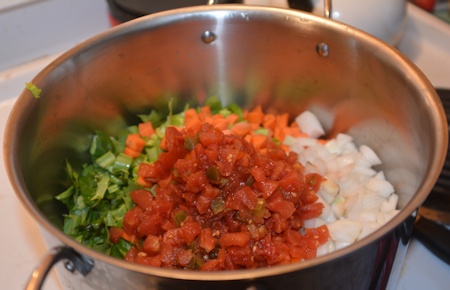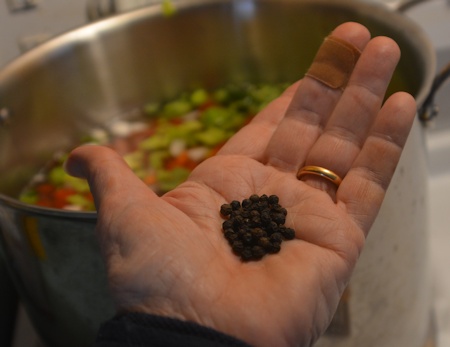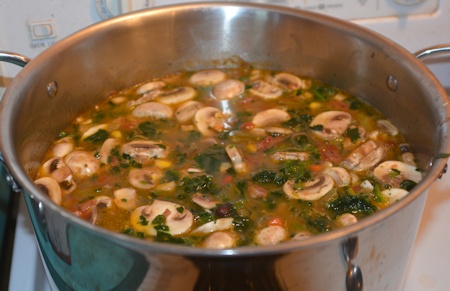Because I have other snug deadlines coming up, I decided to post about soup (the soup on the stove at the moment) instead. This is another of this winter’s mix of dry beans and vegetables with some kind of meat (it’s varied, from October until now, mostly some kind of pork–a ham bone, scraps of ham, pork hocks with or without bone, smoked pork pieces–and beef, tougher cuts.)
The dry beans are a mix that I’ve found we all like when cooked. They soak at least 5 hours and usually overnight. I start with a quart of the mix. The local supermarkets carry pinto beans, small red, red kidney, Great Northern (white), Navy beans (white), black beans, Anasazi beans (a lovely dark red and white splotched), and black-eyed peas. I buy one pound bags of each type and mix them all up in a big old pickle jar for storage, then measure out a quart for each batch. I don’t always use the black-eyed peas. This particular soup started with a package of boneless smoked pork hocks, 3 pounds, the quart of dry beans soaked (I haven’t measured how much they swell, but they rise out of the soaking water, so I’m guessing half again to twice as much, depending on the length of soaking), a medium-large onion, half a bunch of celery chopped (maybe 4 cups of leaves and ribs?) and half a gigantic carrot, diced. With all that in the 12 quart pot, this is what it looked like:

The soaked beans are covering the pork hocks and somewhat mounded in the center (they go in first). Next comes the Ro-tel, a 28 oz can. With these four basics in, there’s just about six quarts of “stuff” in the 12 quart pot.

I add some of the seasoning: whole black peppercorns, about the same of Savory Spices “Peruvian Chili Lime” blend, “enough” bay leaves (the new jar of bay leaves had tiny ones, so I put in five), homemade stock if I have any left (not right now) or a commercial product if I don’t. Then I add cold water to just cover everything because I want to keep the soup from being too dilute and having to reduce it (flavor elements that are water soluble can escape in steam. Flavor elements that are fat-soluble will escape if the soup boils too vigorously.) Picture below shows my measure of peppercorns for this size soup. My mother taught me what she learned from her mother and grandmother on how to measure certain things in the hollow of your hand. This is how many we like; cooking is all about the flavors each person/family likes. In the background, you can see the celery pieces just barely floating.

The soup is brought to a boil, then the temp lowered to a guesstimated maintenance simmer (to be checked off and on, and adjusted) and the top goes on. It gets an hour or two at the simmer, before I taste the broth. It should have a vegetable-y flavor with a good balance of sweet to “green/sour”…important not to have too much carrot or it will be too sweet, and since this soup will have sweet corn kernels, that would make it worse. This one was fine. At about two hours in, I add the (frozen) yellow corn kernels and (frozen) cut green beans, bringing the heat up again, and then stabilizing it in a good simmer. It’s getting a good stir every 20 minutes or so to ensure that nothing’s sitting on the bottom. After the corn & beans go in and it’s been stirred, while it’s heating up again from the frozen additions, it looks like this:

Some of the pork hocks show on the surface, buoyed up by their fat (which I can remove easily now), and the tomato, carrot, celery, and onion can be distinguished by eye, though this picture doesn’t make that clear. The liquid is thicker than it was to start with, when it was just water, but it’s not nearly as rich as it will be when it’s ready to eat. The next elements to add will be the mushrooms (once I get them sliced) and the frozen chopped spinach (a pound package.) An hour after this picture was taken, the broth had thickened a little more, passing the “condensed soup” look. Thickness, again, is a personal choice. I like winter soups to be “dense” with the vegetables, beans, and meat in them…every spoonful to have a variety of things in it and a bowl of the soup to be satisfying. I like summer soups to be lighter, the broth more translucent, the things in the soup more separated. There are other things that could be added to this, of course: some people would add squash, or beets, or green peas, and if I had a functional garden now, so might I. Cabbage is common in winter soups and I used to put it in every soup–until my body decided that it and cabbage were enemies, sometime in my forties. At any rate, I need to go slice a package of mushrooms now and toss them in. I may re-open this file and put more pictures in, later in the process.
Picture below is an hour or so (or more?) after the one above, right after I put in the mushrooms and the spinach. Delays and interruptions had occurred. Mushrooms aren’t done, spinach is still in clumps, but I got a lot of the hocks more or less cut up (with a spoon…they’re falling apart, which is perfect. When I come in from feeding horses and doing their water, I’ll check the beans, then add a quart of water and the barley, and 45 minutes after *that*, we should be eating it. If the beans are done. Some of the varieties take longer to give up their hard dry insides than others. Black beans and small red beans are particularly resistant, but the flavor when they *do* get velvety is so good. You can see that the broth is more opaque. It’s not the deep rich mouth-filling broth of the second or third day soup, but it’s already better than it was.


For this Englishwoman, that is a stew, not a soup! Soups here are usually (but not invariably) blended after cooking. Yours looks lovely, only I dislike cooked celery, so would omit that, I think.
How interesting! Here, a stew has a thicker liquid than a soup, usually thickened with something like flour, and often containing only meat, onion, potato, and carrot (celery and garlic are common, but not nearly universal, but potato, carrot, onion is.) Many soups are not blended (cream soups are.) Love learning about alternate terminologies. I find celery indispensable in cooking…both the leaves and the ribs. I wouldn’t serve it as a solo vegetable (I like it better raw when it’s on its own) but as one of aromatics, yeah. Is it the texture or the flavor that puts you off? And what do you use to offset the sweetness of carrot? A different herb?
I suspect there is a genetic issue with celery – I know of a small number of people who simply cannot stand celery and find if it has been in contact with anything that is also uneatable. Other I suspect simply do not get that taste/smell that indices an almost immediate gag response. I use lots of other herbs not sure anything specifically to counter carrots though. My wife can happily eat celery – I can barely be in the same room.
I suspect a genetic issue with many foods that people don’t tolerate well (but are short of the formal “allergic” diagnosis.) But also a cultivation issue. I tolerated the cabbage family for decades before suddenly I couldn’t. I suspect that the chemicals now used so widely on crops may be *part* of the problem for some, having grown up in an area that grew vegetables in winter for the northern markets, in a time when pesticides were constantly shifting their chemical composition. The cabbage problem hit after years away, returning to my home area, and once again being exposed to small amounts of different pesticides from aerial application. But definitely genetics is part of it, because the peaches thing started in infancy, the first time my mother fed me strained peaches. Melons were slower, but now I can’t be in a room with a cantaloupe; the smell nauseates me.
That looks similar to a minestrone soup that my mother made and that I make, except slightly different proportions of the vegetables and adding pasta instead of the pork hocks. I also use stock rather than water, either turkey (when I have plenty in the freeze from the Christmas bird) or chicken at other times of the year. Good rib-sticking stuff. 🙂 Definitely something to make in batch and freeze.
My husband is convinced that I have no idea how to make a soup that won’t hold my spoon up. I love reading your mixes and while they won’t work for us (I don’t do anything remotely spicy) but I get ideas and sometimes make something for DH that is just for him because I can’t/won’t eat it (things I am allergic to often taste spicy to me so my body is convinced that spice = EVIL).
Can’t argue with the body’s decisions on what it will and won’t tolerate. None of mine are life-threatening (like a friend’s egg allergy or another friend’s shellfish allergy) but the interior upset is sufficiently painful and interrupting of anything else that I don’t even try to eat whatever it is. So not going to argue with or shame anyone who can’t eat something. If my soups give you a useful idea, fine, and if they don’t, feel free to ignore. My list of “can’t eat that” includes quite a few fruits (and any fruits in large amounts), melons, the cabbage family (except mustard as flavoring, thank goodness because I love mustard in and on things). Can’t eat peaches, oranges, grapefruit (can drink a *little* orange juice w/o disaster and use lemon and lime juices in cooking). Potatoes, rice, barley, oats, wheat…safe. Beans…safe in moderation (per serving). Carrots, celery, onion, garlic…safe. Lettuce…safe. Squash family…depends which. Zucchini in soup is fine. Winter squash soups…one cup may be OK, but full serving no. Spices in general…and moderately hot…fine.
My 88 year old mother has decided in the past six months or so that she gets bored with eating the same thing more than one or at most two meals. So, soup has become more difficult to do. We have grocery stores here in AZ that sell Kroger products, and they make a 1 pound bag of frozen “Soup Starter Vegetable” mix that has a little bit of a lot of things: carrot, onion, celery, potato, corn, peas, okra, green beans, and small white beans. It has no salt which is really helpful when watching sodium for heart disease issues. I use about two cups of broth or stock, the bag of veggies, let that simmer until the carrots are cooked, then add something else, sometimes a bit of left over roast beef, chicken, turkey, once a friend brought some ground lamb that her husband had bought then didn’t like so I put that in the soup. different types of herbs for seasoning depending on the meat, and sometimes add a bit of pasta if there is any left. Once I had left over spaghetti sauce that I threw in the soup, just to get it out of the refrigerator and it was surprisingly good. The best part of that is it usually is less than 2 quarts total, so we don’t have the dreaded “I don’t want to eat left overs” going on. We are also like Eowyn and don’t do pepper or chili in soup.
Yeah, lots of things can go in a soup. And it’s low sodium until it’s in the bowl…I don’t salt the pot of soup at all, so everyone eating it can choose. I’ve added a little pasta (sometimes in summer use the pasta for just a bit of thickening), spaghetti sauce, even part of a jar of gravy, depending on what’s open in the fridge. The advantage (for me) is that making the big soups means I only have to make soup totally from scratch in winter, and freezing a quart or several from each batch means summer soups are taken care of…just dilute as needed, if we do need more than a quart at a time. But then I have, now, the freezer capacity to do that. Soup’s so forgiving, and your method sounds perfect for your situation.
I don’t think I’ve ever had cooked celery, but that soup looks delicious! Much better than the pitiful can of Chicken Noodle I had for dinner.
Celery is the foundation of many French dishes: onion, carrot, celery (all chopped). It has a name, but I can’t remember it this morning (too cold still.) It balances the sweetness of the carrot and some onions; the leaves are especially good for a soup. I like 2x the celery to 1 of carrot, but it kinda depends on what else you’ve got in there.